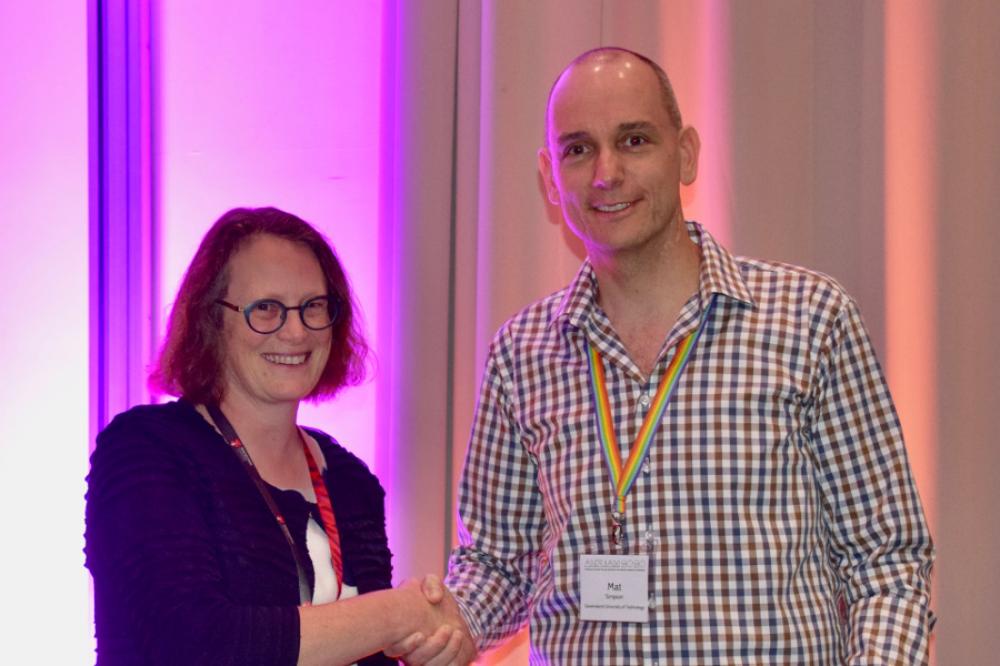The 2020 EO Tuck Medal
Professor Matthew Simpson, from Queensland University of Technology, is an outstanding applied mathematician and a committed leader in the ANZIAM community.

(Photo credit: Mark McGuinness)
Matthew’s research uses computational and analytical methods for solving mathematical models of biological and physical systems. Since graduating his PhD in 2004 from the University of Western Australia, Matthew has established a very strong record of research. He has produced more than 150 refereed journal articles, the majority of which are in the leading journals in their field. He has been awarded $2M in external funding, including 4 ARC Discovery Grants, 3 as lead Chief Investigator, an ARC Future Fellowship, an ARC Postdoctoral Research Fellowship. In addition to the ARC, Matthew has received funding from the Marsden Fund (New Zealand), the Royal Society (United Kingdom) and the USA Aerospace Research Program.
Matthew’s PhD research involved designing and analysing novel computational algorithms to solve mathematical models that predict how fresh and saline fluids mix in coastal aquifers. Supported by a Small Grant from the Australian Research Council (ARC), this work led to publications in Water Resources Research, Advances in Water Resources, Journal of Hydrology and Groundwater that have since received almost 500 citations.
In his postdoctoral career Matthew led projects that used mathematical models to design and interpret experiments on the spatial organization of cell function within an invading population of biological cells. Publications in Developmental Biology, Journal of Theoretical Biology and Development, Growth and Differentiation have been cited more than 300 times. Matthew collaborated with colleagues from the University of Melbourne to develop new theoretical tools to describe multiscale data from cell biology experiments. Publications in Physical Review E and Physica A have been cited more than 330 times.
Matthew’s more recent work involves the development and application of mathematical tools for describing collective migration of populations of adhesive biological cells and the development and use of mathematical models to study a range of biomedical phenomena including: melanoma invasion into intact, three-dimensional human skin tissues; burn injuries in living three-dimensional tissues; and optimal control of leukemia treatment. He has also led projects on the analysis of stochastic models of cell migration which have resulted in the derivation of new continuum-limit descriptions of these models.
Matthew continually fosters new projects and collaborations. In 2018 he worked with medical researchers at the University of Queensland to develop continuum and discrete mathematical models of cell migration that describe experiments performed with a new individual florescent cell labelling and imaging technique called FUCCI. This new technology is revolutionising experimental cell biology research and Matthew and his group are the first to develop mathematical models of this emerging technology. This work has been published in prestigious journals, such as Biophysical Journal and the Journal of the Royal Society Interface and Matthew was invited to write a popular science article about FUCCI modelling, which was published on the front cover of SIAM News in 2019.
The national and international research community has recognised Matthew’s research achievements by inviting him to make several plenary presentations, including: Australian Society for Medical Research; ANZIAM; Australasian Wound and Tissue Repair Society; Kyushu University Mathematics-for-Industry Forum; Swinburne Archimedes Lecture; and SIAM Life Sciences. Matthew was awarded the JH Michell Medal in 2012.
Matthew’s service to the Australian and New Zealand applied mathematics community is also noteworthy. He has made significant contributions to the teaching and supervision of students (7 PhD and 2 MPhil students completed) and emerging researchers (4 postdoctoral research fellows). He is currently an Associate Editor of the Journal of Engineering Mathematics and the ANZIAM Journal. In 2018 Matthew chaired the scientific committee for the annual meeting of the international Society for Mathematical Biology (SMB) in Sydney. In 2017 Matthew was appointed to an International Advisory Panel to conduct a mid-term review of Te Pūnaha Matatini, a Centre for Research Excellence funded by the New Zealand Government’s Tertiary Education Commission.
Matthew was elected to the ARC College of Experts from 2016 to 2018 and is currently the Deputy Director of the Australian Mathematical Sciences Institute (AMSI) where he chairs the AMSI Research and Higher Education Committee and jointly coordinates the Vacation Research Program. In 2015 he Co-directed the highly successful 51st meeting of ANZIAM on the Gold Coast and he has contributed to many ANZIAM committees including those for the Thomas Cherry Prize, the JH Michell Medal and the development of the ANZIAM Code of Conduct. He is a past Queensland representative on the national ANZIAM Executive Committee.
The selection panel unanimously recommends that Professor Matthew Simpson be awarded the ANZIAM E.O. Tuck Medal for 2020.
On behalf of ANZIAM:
Troy Farrell (QUT)
Shaun Hendy (University of Auckland)
Yvonne Stokes (University of Adelaide)


